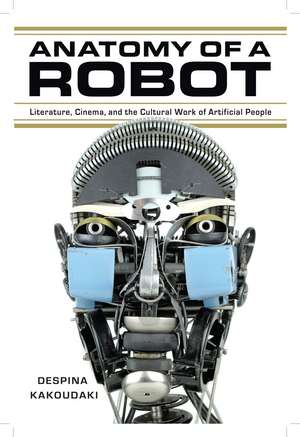Anatomy of a Robot: Literature, Cinema, and the Cultural Work of Artificial People
Autor Despina Kakoudakien Limba Engleză Paperback – 7 iul 2014
Why do we find artificial people fascinating? Drawing from a rich fictional and cinematic tradition, Anatomy of a Robot explores the political and textual implications of our perennial projections of humanity onto figures such as robots, androids, cyborgs, and automata. In an engaging, sophisticated, and accessible presentation, Despina Kakoudaki argues that, in their narrative and cultural deployment, artificial people demarcate what it means to be human. They perform this function by offering us a non-human version of ourselves as a site of investigation. Artificial people teach us that being human, being a person or a self, is a constant process and often a matter of legal, philosophical, and political struggle.
By analyzing a wide range of literary texts and films (including episodes from Twilight Zone, the fiction of Philip K. Dick, Kazuo Ishiguro’s novel Never Let Me Go, Metropolis, The Golem, Frankenstein, The Terminator, Iron Man, Blade Runner, and I, Robot), and going back to alchemy and to Aristotle’s Physics and De Anima, she tracks four foundational narrative elements in this centuries-old discourse— the fantasy of the artificial birth, the fantasy of the mechanical body, the tendency to represent artificial people as slaves, and the interpretation of artificiality as an existential trope. What unifies these investigations is the return of all four elements to the question of what constitutes the human.
This focused approach to the topic of the artificial, constructed, or mechanical person allows us to reconsider the creation of artificial life. By focusing on their historical provenance and textual versatility, Kakoudaki elucidates artificial people’s main cultural function, which is the political and existential negotiation of what it means to be a person.
By analyzing a wide range of literary texts and films (including episodes from Twilight Zone, the fiction of Philip K. Dick, Kazuo Ishiguro’s novel Never Let Me Go, Metropolis, The Golem, Frankenstein, The Terminator, Iron Man, Blade Runner, and I, Robot), and going back to alchemy and to Aristotle’s Physics and De Anima, she tracks four foundational narrative elements in this centuries-old discourse— the fantasy of the artificial birth, the fantasy of the mechanical body, the tendency to represent artificial people as slaves, and the interpretation of artificiality as an existential trope. What unifies these investigations is the return of all four elements to the question of what constitutes the human.
This focused approach to the topic of the artificial, constructed, or mechanical person allows us to reconsider the creation of artificial life. By focusing on their historical provenance and textual versatility, Kakoudaki elucidates artificial people’s main cultural function, which is the political and existential negotiation of what it means to be a person.
Preț: 217.18 lei
Preț vechi: 255.45 lei
-15% Nou
Puncte Express: 326
Preț estimativ în valută:
41.56€ • 45.13$ • 34.91£
41.56€ • 45.13$ • 34.91£
Carte indisponibilă temporar
Doresc să fiu notificat când acest titlu va fi disponibil:
Se trimite...
Preluare comenzi: 021 569.72.76
Specificații
ISBN-13: 9780813562155
ISBN-10: 0813562155
Pagini: 272
Ilustrații: 26 photographs
Dimensiuni: 152 x 229 x 23 mm
Greutate: 0.43 kg
Ediția:None
Editura: Rutgers University Press
Colecția Rutgers University Press
ISBN-10: 0813562155
Pagini: 272
Ilustrații: 26 photographs
Dimensiuni: 152 x 229 x 23 mm
Greutate: 0.43 kg
Ediția:None
Editura: Rutgers University Press
Colecția Rutgers University Press
Notă biografică
DESPINA KAKOUDAKI is an associate professor in the department of literature at American University in Washington, D.C.
Cuprins
Acknowledgments
Introduction: Robot Anatomies
1 The Artificial Birth
2 The Mechanical Body
3 The Mechanical Slave
4 The Existential Cyborg
Conclusion: The Ends of the Human
Notes
Index
Recenzii
"Wide-ranging in its examples, erudite, politically relevant, and profound in its implications, this book is essential for anyone interested in our long history with created others."
"Anatomy of a Robot offers an insightful analysis of the cultural work artificial people perform as they elucidate what it is to be human; a refreshing intervention in the field and impressive in its breadth."
"This book is literary criticism that looks at the robot as a trope across media, from ancient myths to modern-day movies. The book has four overarching themes that Kakoudaki presents in separate chapters: 'The Artificial Birth,' 'The Mechanical Body,' 'The Mechanical Slave,' and 'The Existential Cyborg.' [Kakoudaki provides] a great deal of historical and cultural depth, exploring a diversity of tropes across all of recorded history. Highly recommended."
Descriere
Drawing from a rich fictional and cinematic tradition, Anatomy of a Robot explores the political and textual implications of our perennial projections of humanity onto figures such as robots, androids, cyborgs, and automata. In an engaging, sophisticated, and accessible presentation, Despina Kakoudaki argues that, in their narrative and cultural deployment, artificial people demarcate what it means to be human.
